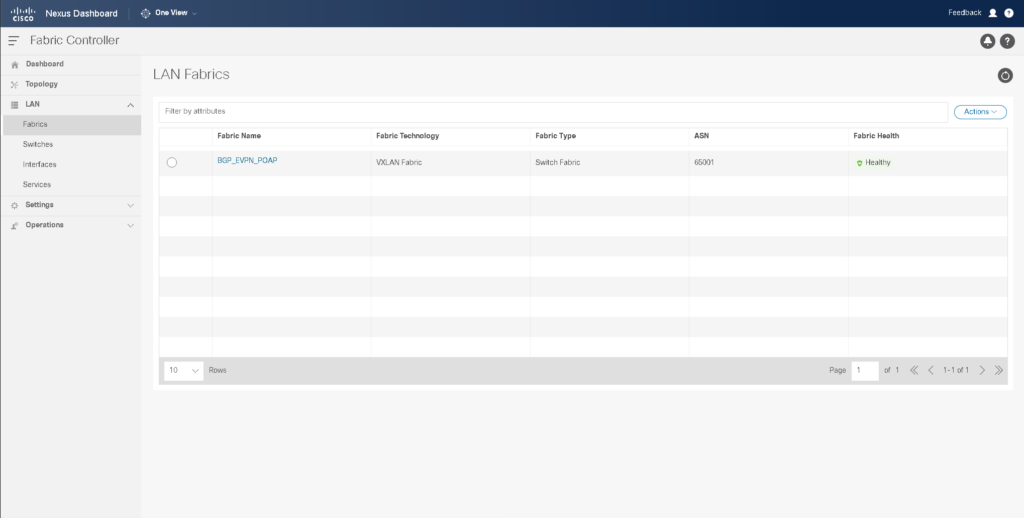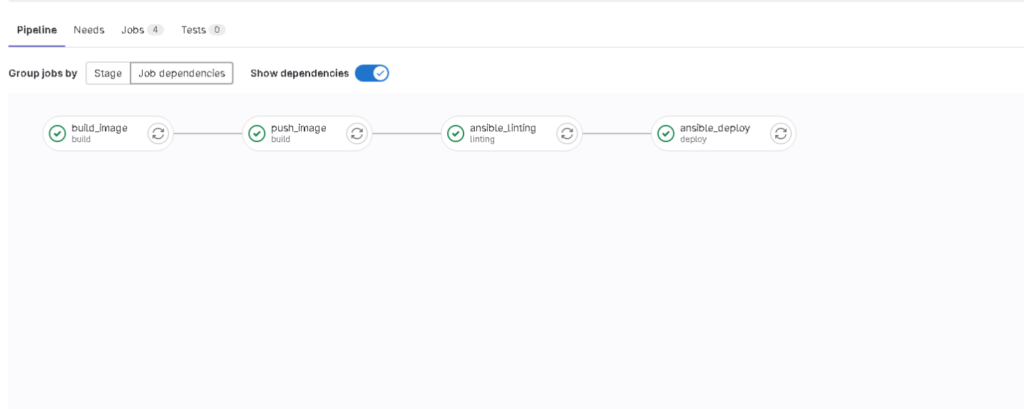Table of Contents
Introduction
If you want to build BGP EVPN based Datacenter fabrics, Cisco’s answer is NDFC (Nexus Dashboard Fabric Controller).
Cisco Nexus Dashboard Fabric Controller (NDFC) is a network automation and management solution offered by Cisco. NDFC provides a single dashboard for managing and automating network operations across multi-cloud, on-premises, and edge environments.
In this article, I am describing how to build a BGP EPVN fabric and provision Spine and Leaf switches using POAP (PowerOn auto-provisioning) with Ansible modules.
POAP is being used to configure and update devices once they are booted and come up without any configuration. It is a very convenient way to configure the fabric, add the devices and then just turn on the devices in the data center and everything gets configured automatically!
Lab setup
My entire environment is fully virtualized. I am running a virtual Nexus Dashboard and CML (Cisco Modelling Labs) to simulate my Nexus devices.
If you want to replicate this setup as well, make sure to allocate enough resources for the Nexus Dashboard (16x vCPUs and 64GB RAM).
https://www.cisco.com/c/en/us/td/docs/dcn/nd/2x/deployment/cisco-nexus-dashboard-deployment-guide-221/nd-deploy-esx-22x.html
As always I run the code in a GitLab CI/CD pipeline and it is executed within a Docker container. The Docker container is stored in my own GitLab Docker registry. If you don’t know how to set up the GitLab server with a Docker registry, check out my previous article:
Docker container
For this use case I am using a very basic Docker container with:
- Ansible
- Ansible lint
- Ansible Galaxy collection dcnm (the name of the previous version of NDFC)
Cisco is a master in renaming products 😉
FROM ubuntu:22.04
RUN apt-get update && \
apt-get install -y gcc python3.11 git python3-pip ssh && \
pip3 install --upgrade pip && \
pip3 install ansible requests && \
pip3 install jmespath && \
pip3 install ansible-lint && \
ansible-galaxy collection install cisco.dcnm
Building the container in a pipeline
variables:
IMAGE_NAME: $CI_REGISTRY_IMAGE/ndfc-automation
IMAGE_TAG: "1.0"
stages:
- build
build_image:
stage: build
tags:
- shell-runner
script:
- docker build -t $IMAGE_NAME:$IMAGE_TAG .
push_image:
stage: build
needs:
- build_image
tags:
- shell-runner
before_script:
- docker login -u $CI_REGISTRY_USER -p $CI_REGISTRY_PASSWORD $CI_REGISTRY
script:
- docker push $IMAGE_NAME:$IMAGE_TAG
Building the data model
As the base is set now, it is time to build the data model. If you create a BGP EVPN fabric there are a lot of variables you need to deal with. That’s why I created the following data model which I will load later into my Ansible playbook:
fabric_settings.yaml:
To create the fabric I am using the Easy_Fabric template and left pretty much everything as a default value. The only values I changed are:
- Fabric name
- BGP AS
- Bootstrap settings (DHCP,Gateway)
---
fabricName: BGP_EVPN_POAP
templateName: Easy_Fabric
nvPairs:
FABRIC_NAME: BGP_EVPN_POAP
BGP_AS: '65001'
UNDERLAY_IS_V6: 'false'
USE_LINK_LOCAL: false
V6_SUBNET_TARGET_MASK: ''
LINK_STATE_ROUTING: ospf
RR_COUNT: '2'
ANYCAST_GW_MAC: 2020.0000.00aa
PM_ENABLE: 'false'
BGP_AS_PREV: ''
PM_ENABLE_PREV: 'false'
ENABLE_FABRIC_VPC_DOMAIN_ID_PREV: ''
FABRIC_VPC_DOMAIN_ID_PREV: ''
LINK_STATE_ROUTING_TAG_PREV: ''
OVERLAY_MODE_PREV: ''
ENABLE_PVLAN_PREV: ''
FABRIC_MTU_PREV: '9216'
L2_HOST_INTF_MTU_PREV: '9216'
DEPLOYMENT_FREEZE: 'false'
INBAND_MGMT_PREV: 'false'
BOOTSTRAP_ENABLE_PREV: 'false'
MGMT_V6PREFIX: '64'
ENABLE_NETFLOW_PREV: ''
VPC_DELAY_RESTORE_TIME: '60'
FABRIC_TYPE: Switch_Fabric
ENABLE_AGENT: 'false'
AGENT_INTF: eth0
SSPINE_ADD_DEL_DEBUG_FLAG: Disable
BRFIELD_DEBUG_FLAG: Disable
ACTIVE_MIGRATION: 'false'
FF: Easy_Fabric
MSO_SITE_ID: ''
MSO_CONTROLER_ID: ''
MSO_SITE_GROUP_NAME: ''
PREMSO_PARENT_FABRIC: ''
MSO_CONNECTIVITY_DEPLOYED: ''
ANYCAST_RP_IP_RANGE_INTERNAL: ''
DHCP_START_INTERNAL: ''
DHCP_END_INTERNAL: ''
MGMT_GW_INTERNAL: ''
MGMT_PREFIX_INTERNAL: ''
BOOTSTRAP_MULTISUBNET_INTERNAL: ''
MGMT_V6PREFIX_INTERNAL: ''
DHCP_IPV6_ENABLE_INTERNAL: ''
UNNUM_DHCP_START_INTERNAL: ''
UNNUM_DHCP_END_INTERNAL: ''
ENABLE_EVPN: 'true'
FEATURE_PTP_INTERNAL: 'false'
SSPINE_COUNT: '0'
SPINE_COUNT: '0'
abstract_feature_leaf: base_feature_leaf_upg
abstract_feature_spine: base_feature_spine_upg
abstract_dhcp: base_dhcp
abstract_multicast: base_multicast_11_1
abstract_anycast_rp: anycast_rp
abstract_loopback_interface: int_fabric_loopback_11_1
abstract_isis: base_isis_level2
abstract_ospf: base_ospf
abstract_vpc_domain: base_vpc_domain_11_1
abstract_vlan_interface: int_fabric_vlan_11_1
abstract_isis_interface: isis_interface
abstract_ospf_interface: ospf_interface_11_1
abstract_pim_interface: pim_interface
abstract_route_map: route_map
abstract_bgp: base_bgp
abstract_bgp_rr: evpn_bgp_rr
abstract_bgp_neighbor: evpn_bgp_rr_neighbor
abstract_extra_config_leaf: extra_config_leaf
abstract_extra_config_spine: extra_config_spine
abstract_extra_config_tor: extra_config_tor
abstract_extra_config_bootstrap: extra_config_bootstrap_11_1
temp_anycast_gateway: anycast_gateway
temp_vpc_domain_mgmt: vpc_domain_mgmt
temp_vpc_peer_link: int_vpc_peer_link_po
abstract_routed_host: int_routed_host
abstract_trunk_host: int_trunk_host
L3VNI_MCAST_GROUP: ''
PHANTOM_RP_LB_ID1: ''
PHANTOM_RP_LB_ID2: ''
PHANTOM_RP_LB_ID3: ''
PHANTOM_RP_LB_ID4: ''
VPC_PEER_LINK_VLAN: '3600'
ENABLE_VPC_PEER_LINK_NATIVE_VLAN: 'false'
VPC_PEER_KEEP_ALIVE_OPTION: management
VPC_AUTO_RECOVERY_TIME: '360'
VPC_DELAY_RESTORE: '150'
VPC_PEER_LINK_PO: '500'
VPC_ENABLE_IPv6_ND_SYNC: 'true'
ADVERTISE_PIP_BGP: 'false'
ENABLE_FABRIC_VPC_DOMAIN_ID: 'false'
FABRIC_VPC_DOMAIN_ID: ''
FABRIC_VPC_QOS_POLICY_NAME: ''
BGP_LB_ID: '0'
NVE_LB_ID: '1'
ANYCAST_LB_ID: ''
LINK_STATE_ROUTING_TAG: UNDERLAY
OSPF_AUTH_KEY_ID: ''
OSPF_AUTH_KEY: ''
ISIS_LEVEL: ''
ISIS_P2P_ENABLE: false
ISIS_AUTH_ENABLE: false
ISIS_AUTH_KEYCHAIN_NAME: ''
ISIS_AUTH_KEYCHAIN_KEY_ID: ''
ISIS_AUTH_KEY: ''
ISIS_OVERLOAD_ENABLE: false
ISIS_OVERLOAD_ELAPSE_TIME: ''
BGP_AUTH_KEY_TYPE: ''
BGP_AUTH_KEY: ''
PIM_HELLO_AUTH_KEY: ''
BFD_IBGP_ENABLE: false
BFD_OSPF_ENABLE: false
BFD_ISIS_ENABLE: false
BFD_PIM_ENABLE: false
BFD_AUTH_ENABLE: false
BFD_AUTH_KEY_ID: ''
BFD_AUTH_KEY: ''
IBGP_PEER_TEMPLATE: ''
IBGP_PEER_TEMPLATE_LEAF: ''
default_vrf: Default_VRF_Universal
default_network: Default_Network_Universal
vrf_extension_template: Default_VRF_Extension_Universal
network_extension_template: Default_Network_Extension_Universal
OVERLAY_MODE: config-profile
ENABLE_PVLAN: 'false'
default_pvlan_sec_network: ''
FABRIC_MTU: '9216'
L2_HOST_INTF_MTU: '9216'
HOST_INTF_ADMIN_STATE: 'true'
POWER_REDUNDANCY_MODE: ps-redundant
COPP_POLICY: strict
HD_TIME: '180'
BROWNFIELD_NETWORK_NAME_FORMAT: Auto_Net_VNI$$VNI$$_VLAN$$VLAN_ID$$
BROWNFIELD_SKIP_OVERLAY_NETWORK_ATTACHMENTS: 'false'
CDP_ENABLE: 'false'
ENABLE_NGOAM: 'true'
ENABLE_TENANT_DHCP: 'true'
ENABLE_NXAPI: 'true'
ENABLE_PBR: 'false'
STRICT_CC_MODE: 'false'
AAA_REMOTE_IP_ENABLED: 'false'
SNMP_SERVER_HOST_TRAP: 'true'
ANYCAST_BGW_ADVERTISE_PIP: 'false'
PTP_LB_ID: ''
PTP_DOMAIN_ID: ''
MPLS_LB_ID: ''
TCAM_ALLOCATION: 'true'
DEAFULT_QUEUING_POLICY_CLOUDSCALE: ''
DEAFULT_QUEUING_POLICY_R_SERIES: ''
DEAFULT_QUEUING_POLICY_OTHER: ''
ENABLE_MACSEC: 'false'
MACSEC_KEY_STRING: ''
MACSEC_ALGORITHM: ''
MACSEC_FALLBACK_KEY_STRING: ''
MACSEC_FALLBACK_ALGORITHM: ''
MACSEC_CIPHER_SUITE: ''
MACSEC_REPORT_TIMER: ''
STP_ROOT_OPTION: unmanaged
STP_VLAN_RANGE: ''
MST_INSTANCE_RANGE: ''
STP_BRIDGE_PRIORITY: ''
EXTRA_CONF_LEAF: ''
EXTRA_CONF_SPINE: ''
EXTRA_CONF_TOR: ''
EXTRA_CONF_INTRA_LINKS: ''
STATIC_UNDERLAY_IP_ALLOC: 'false'
MPLS_LOOPBACK_IP_RANGE: ''
LOOPBACK0_IPV6_RANGE: ''
LOOPBACK1_IPV6_RANGE: ''
V6_SUBNET_RANGE: ''
ROUTER_ID_RANGE: ''
L2_SEGMENT_ID_RANGE: 30000-49000
L3_PARTITION_ID_RANGE: 50000-59000
NETWORK_VLAN_RANGE: 2300-2999
VRF_VLAN_RANGE: 2000-2299
SUBINTERFACE_RANGE: 2-511
VRF_LITE_AUTOCONFIG: Manual
AUTO_SYMMETRIC_VRF_LITE: false
AUTO_VRFLITE_IFC_DEFAULT_VRF: false
AUTO_SYMMETRIC_DEFAULT_VRF: false
DEFAULT_VRF_REDIS_BGP_RMAP: ''
DCI_SUBNET_RANGE: 10.33.0.0/16
DCI_SUBNET_TARGET_MASK: '30'
SERVICE_NETWORK_VLAN_RANGE: 3000-3199
ROUTE_MAP_SEQUENCE_NUMBER_RANGE: 1-65534
DNS_SERVER_IP_LIST: ''
DNS_SERVER_VRF: ''
NTP_SERVER_IP_LIST: ''
NTP_SERVER_VRF: ''
SYSLOG_SERVER_IP_LIST: ''
SYSLOG_SEV: ''
SYSLOG_SERVER_VRF: ''
AAA_SERVER_CONF: ''
BOOTSTRAP_ENABLE: true
DHCP_START: 198.18.1.200
DHCP_END: 198.18.1.250
MGMT_GW: 198.18.1.1
SEED_SWITCH_CORE_INTERFACES: ''
SPINE_SWITCH_CORE_INTERFACES: ''
INBAND_DHCP_SERVERS: ''
UNNUM_BOOTSTRAP_LB_ID: ''
UNNUM_DHCP_START: ''
UNNUM_DHCP_END: ''
BOOTSTRAP_CONF: ''
enableRealTimeBackup: ''
enableScheduledBackup: ''
scheduledTime: ''
ENABLE_NETFLOW: 'false'
NETFLOW_EXPORTER_LIST: ''
NETFLOW_RECORD_LIST: ''
NETFLOW_MONITOR_LIST: ''
FABRIC_INTERFACE_TYPE: p2p
SUBNET_TARGET_MASK: '30'
REPLICATION_MODE: Multicast
VPC_DOMAIN_ID_RANGE: 1-1000
FABRIC_VPC_QOS: 'false'
OSPF_AREA_ID: 0.0.0.0
OSPF_AUTH_ENABLE: 'false'
BGP_AUTH_ENABLE: 'false'
BFD_ENABLE: 'false'
ENABLE_NXAPI_HTTP: 'true'
GRFIELD_DEBUG_FLAG: Disable
FEATURE_PTP: 'false'
MPLS_HANDOFF: 'false'
ENABLE_DEFAULT_QUEUING_POLICY: 'false'
LOOPBACK0_IP_RANGE: 10.2.0.0/22
LOOPBACK1_IP_RANGE: 10.3.0.0/22
SUBNET_RANGE: 10.4.0.0/16
INBAND_MGMT: 'false'
MULTICAST_GROUP_SUBNET: 239.1.1.0/25
ENABLE_TRM: 'false'
RP_COUNT: '2'
RP_MODE: asm
RP_LB_ID: '254'
PIM_HELLO_AUTH_ENABLE: 'false'
ANYCAST_RP_IP_RANGE: 10.254.254.0/24
DHCP_ENABLE: true
ENABLE_AAA: 'false'
SITE_ID: '65001'
DHCP_IPV6_ENABLE: DHCPv4
BOOTSTRAP_MULTISUBNET: "#Scope_Start_IP, Scope_End_IP, Scope_Default_Gateway, Scope_Subnet_Prefix"
MGMT_PREFIX: '24'
fabric_inventory.yaml:
It also makes sense to create a separate file for the switch inventory details. The most important information is the serial number of the device as we need to map the correct role to each switch (Spine, Leaf, Border-Leaf etc.).
Make sure to have that information handy before starting with POAP!
---
inventory_data:
switches:
- seed_ip: 198.18.1.151
user_name: admin
password: C1sco12345
role: spine
poap:
- serial_number: 9YW0T2HLH4A
model: 'N9K-C9300v'
version: '9.3(11)'
hostname: 'POAP-SPINE01'
config_data:
modulesModel: [N9K-X9364v, N9K-vSUP]
gateway: 198.18.1.1/24
- seed_ip: 198.18.1.152
user_name: admin
password: C1sco12345
role: leaf
poap:
- serial_number: 9BH06YFWE60
model: 'N9K-C9300v'
version: '9.3(11)'
hostname: 'POAP-LEAF01'
config_data:
modulesModel: [N9K-X9364v, N9K-vSUP]
gateway: 198.18.1.1/24
- seed_ip: 198.18.1.153
user_name: admin
password: C1sco12345
role: leaf
poap:
- serial_number: 9TPC3FV5ITL
model: 'N9K-C9300v'
version: '9.3(11)'
hostname: 'POAP-LEAF02'
config_data:
modulesModel: [N9K-X9364v, N9K-vSUP]
gateway: 198.18.1.1/24
Building the playbok
For the Ansible playbook, it just needs four different modules:
-
ansible.builtin.include_vars:
Both defined yaml files needs to be loaded for the fabric and inventory data -
cisco.dcnm.dcnm_rest:
This module is used to create the fabric using the fabric_settings by converting it into JSON payload -
ansible.builtin.pause:
Once the fabric is created it will take some time in order to get the IP address from the DHCP server (in my case the NDFC controller) and the switches are visible in the POAP inventory. -
cisco.dcnm.dcnm_inventory:
The inventory module is used to add and provision the devices into the created fabric
Make sure that the following parameters are set in the ansible.cfg:
---
- name: Create fabric and pre-provision switches # Create fabric and pre-provision switches
hosts: ndfc_controller # ndfc_controller
gather_facts: false
tasks:
- name: Load fabric data # Load fabric data
ansible.builtin.include_vars:
file: data/fabric_settings.yaml
name: fabric_settings
- name: Load inventory data # Load inventory data
ansible.builtin.include_vars:
file: data/fabric_inventory.yaml
name: fabric_inventory
- name: Create template policy using Ansible # Create template policy using Ansible
cisco.dcnm.dcnm_rest:
method: POST
path: /appcenter/cisco/ndfc/api/v1/lan-fabric/rest/control/fabrics
json_data: '{{ fabric_settings | to_json }}'
- name: Sleep # Sleep
ansible.builtin.pause:
seconds: 300
- name: Provision of switch Configuration # Provision switch configuration
cisco.dcnm.dcnm_inventory:
fabric: '{{ fabric_settings.fabricName }}'
state: merged
config: '{{ fabric_inventory.inventory_data.switches }}'
Building the pipeline
The pipeline itself is very simple and consists of three stages:
-
BUILD
The Docker container will be created and uploaded to the GitLab Docker registry -
LINTING
Ansible playbook syntax will be checked against linting rules -
DEPLOY
Ansible playbook will be executed
variables:
IMAGE_NAME: $CI_REGISTRY_IMAGE/ndfc-automation
IMAGE_TAG: "1.0"
stages:
- build
- linting
- deploy
build_image:
stage: build
tags:
- shell-runner
script:
- docker build -t $IMAGE_NAME:$IMAGE_TAG .
push_image:
stage: build
needs:
- build_image
tags:
- shell-runner
before_script:
- docker login -u $CI_REGISTRY_USER -p $CI_REGISTRY_PASSWORD $CI_REGISTRY
script:
- docker push $IMAGE_NAME:$IMAGE_TAG
ansible_linting:
stage: linting
needs:
- push_image
image: $IMAGE_NAME:$IMAGE_TAG
tags:
- docker-runner
before_script:
- cd ansible
script:
- ansible-lint deploy_provision_fabric.yaml
ansible_deploy:
stage: deploy
needs:
- ansible_linting
image: $IMAGE_NAME:$IMAGE_TAG
tags:
- docker-runner
before_script:
- cd ansible
script:
- ansible-playbook deploy_provision_fabric.yaml
Run the pipeline
Let’s run the pipeline and validate the process:
At first, the Ansible play will create the fabric:
After some time once the switches booted up, it will start with the POAP process and sends out DHCP request.
As the fabric has the DHCP server option enabled and a range is assigned, the switches will receive an IP address.
Once the switches become available, which will be after some minutes, they will be added to the fabric.
The switches will download the python script from the NDFC server, configure basic connectivity like IP address and credentials and the switch will reboot.
The Ansible tasks wait for the switches to come back online to configure the “role” (Spine/Leaf) related configurations. This process can take up to 10 – 15 minutes.
Once the switches come back online, the config state is unknown. NDFC will sync this after a while.
Once the config state is synced, NDFC will push the configuration to the switches.
You can see the process more in detail if you go back to the pipeline status. The Ansible module will:
- Add the switches
- Wait to rediscover the devices
- Assign the role
- Saves the config
- Deploys the config to the devices
After a while, you should see that the entire pipeline was executed successfully. 😃
References
- https://www.cisco.com/c/en/us/products/collateral/cloud-systems-management/prime-data-center-network-manager/nb-06-ndfc-ds-cte-en.html
- https://www.cisco.com/site/us/en/products/networking/cloud-networking/nexus-platform/index.html
- https://github.com/CiscoDevNet/ansible-dcnm
- https://www.cisco.com/c/en/us/products/cloud-systems-management/modeling-labs/index.html












